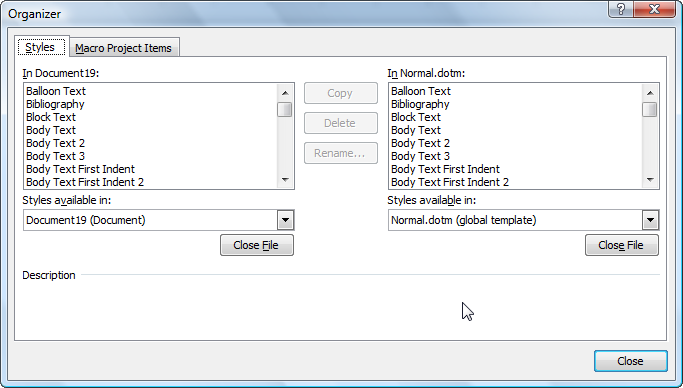
- #HOW TO APPLY THE SHADED STYLE SET IN WORD 2013 HOW TO#
- #HOW TO APPLY THE SHADED STYLE SET IN WORD 2013 WINDOWS#
Texture to something other than wdTextureNone. If you want a pattern to display over the background color Click the arrow for the Style Based On drop-down list. Give your new heading a unique name under the Properties section. You can leave an existing Word heading style as is and create your own, new custom heading based upon it.
#HOW TO APPLY THE SHADED STYLE SET IN WORD 2013 HOW TO#
ForegroundPatternColor is wdColorAutomatic. C Corner: How to Apply and Change Quick Styles in Word 2013 Tips. BackgroundPatternColor to the colour of your choice. How to manage background and foreground coloursīased on these findings, the rules are: If you want a background with a plain, solid colour Texture from the default ( wdTextureNone) to wdTextureSolid. You can perform the same steps for FollowedHyperlink if desired. Select the color you wish to use for hyperlinks. In the Current Style area, select Hyperlink, then choose Modify Style. Select Hyperlink in the Apply a style area. BackgroundPatternColor, Word will change the. At the bottom-left corner in the List box, select All Styles. ForegroundPatternColor to any colour other than wdColorAutomatic, and you don't set the. Move the mouse pointer over the style name and then click on the down-arrow at the right side of the style name. In the task pane, scroll through the list of styles until you see the Caption style. Word displays the Styles and Formatting task pane.

BackgroundPatternColor and ensure that the. Select Styles and Formatting from the Format menu. In the normal course of events, when you just want some coloured shading, set the. ForegroundPatternColor = wdColorAutomatic BackgroundPatternColor = wdColorAutomatic In the object model, a newly-created paragraph style has: If you choose the Solid texture ( wdTextureSolid in the object model), then you only see the foreground colour. The UI won't let you set the foreground colour. In the user interface, if you choose the Clear texture ( wdTextureNone in the object model), then you only see the background colour. The tricky bits come when you try to work out how to manipulate the combination of foreground and background colours, and texture. Relationships between foreground colour, background colour and texture

#HOW TO APPLY THE SHADED STYLE SET IN WORD 2013 WINDOWS#
This example is from Word 2007 on Windows XP.

After you have applied styles, you can modify them and change the font, size, color, and other formatting attributes so the entire document will. The Shading tab of Word's Borders and Shading dialog. Applies to: Microsoft ® Word ® 2010, 2013, 2016, 2019 or 365 (Windows) You can create headings in Microsoft Word documents by applying Words built-in heading styles (such as Heading 1 or Heading 2). Shading object mirror the user interface: Click the dialog launcher in the bottom right corner of the Styles group on the Home tab to open the Styles pane. You can change both font and paragraph formatting at the same time using the document defaults. That is, if you set, say, = wdColorRed, then Word automatically sets the to red. For more on using Quick Style Sets, see this Office Blog entry. These two objects appear to be the same thing. Styles in any style set can be added, removed or modified. Shading object:Īnd, there are two properties of a paragraph style that return a. To do this, go to the Design tab and click the drop-arrow on the right side of the Style Set gallery, then click Save as a New Style Set. This article explains how to manage shading for paragraph styles using the Microsoft Word object model. In the Microsoft Word object model, background and foreground colours are controlled through a Shading object. If you don't want a visible foreground, set the colour to wdColorAutomatic. If you don't want a visible texture, set texture to wdTextureNone. MsgBox "Finished applying borders to " & n & " tables.To set background and foreground colours, do these steps in order: Columns.Count = 1 And oarray(i) = wdBorderVertical Then GoTo Skip 'Skip if only one column and wdBorderVertical To apply one, click inside the table and choose Table Tools> Design and select a table style. Rows.Count = 1 And oarray(i) = wdBorderHorizontal Then GoTo Skip Table Styles govern the look of fonts, alignment, borders, and shading in Word tables. 'Skip if only one row and wdBorderHorizontal 'Define array with the borders to be changed 'Diagonal borders not included here MsgBox "The document contains no tables.", vbInformation, Title "to all tables in the active document." & vbCr & vbCr & _ Msg = "This command applies uniform table borders " & _ Title = "Apply Uniform Borders to All Tables" '= 'Change the values below to the desired style, width and color '= 'The macro applies uniform table borders to all tables in the active document '2: Adjusted to handle tables with only one row or column '1: Adjusted to always fix vertical borders in 1-row tables correctly 'Insert the desired values of oBorderStyle, oBorderWidth and oBorderColor '=

'YOU ARE NOT ALLOWED TO PUBLISH THE MACRO AS YOUR OWN, IN WHOLE OR IN PART. YOU ARE WELCOME TO USE THE MACRO BUT YOU MUST KEEP THE LINE ABOVE. '= 'Macro created 2007 by Lene Fredborg, DocTools - 'THIS MACRO IS COPYRIGHT.


 0 kommentar(er)
0 kommentar(er)
